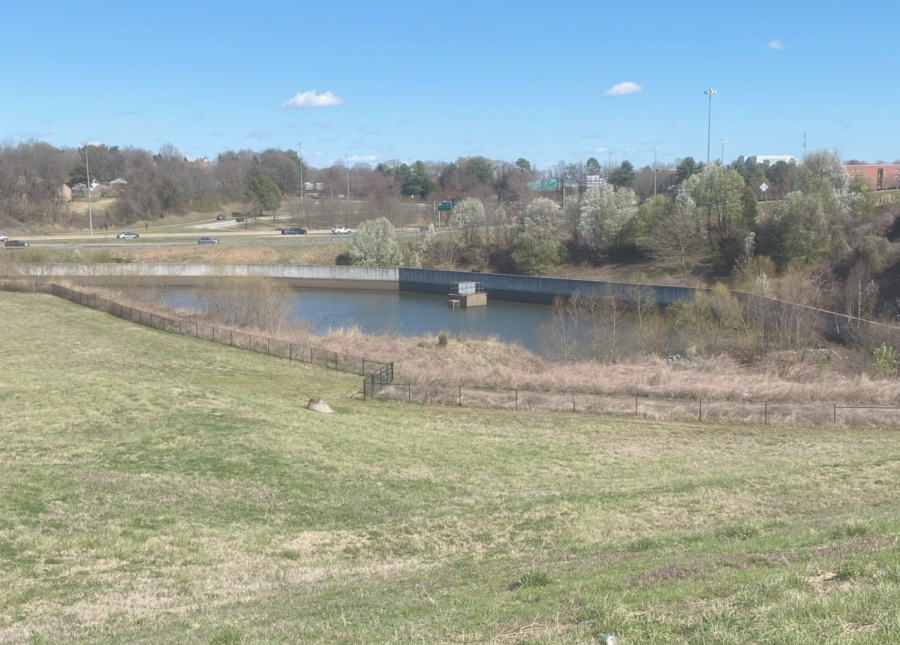Retention pond downtown protects the city
The man-made pond serves an important purpose in keeping the surrounding landscape functional
The somewhat-hidden retention pond sits near the Innovation Quarter downtown.
April 13, 2022
Walking past Wake Downtown, you find yourself on Long Branch Trail, with a hill to your left and downtown Winston-Salem to your right. Over that hill is a large, grassy field and a pond. You might think, “what is that man-made pond doing in between me and US 52?”
Some people walking on Long Branch Trail have never noticed the retention pond over the crest of the hill. Wake Forest student Lily Robinson takes classes at Wake Downtown and walks the trail, but did not know there was a pond so close by.
“There’s a pond on the other side of that hill? I had no idea,” said Robinson.
Amber Dover, a downtown resident, was taking a Sunday afternoon walk on Long Branch Trail with her puppy, very near the retention pond, but she did not know it was there.
“I live at the Link Apartments building in Innovation Quarter, but I did not know there was a retention pond right here,” she said.
Other students are more familiar with the landscape. Hayden Sample is a Wake Forest engineering student who takes classes downtown every day.
“I actually did research last summer that dealt with the tubes that go in and out of a retention pond in Georgia, but I’ve always been curious to know more about how it works, especially since there is one so close to where I take classes,” she said.
Stormwater flooding has been a problem in downtown Winston-Salem as new development has skyrocketed in recent years. According to the United States Geological Survey, when new development is added to an area, the land changes and the chances of it flooding are affected in many ways. This is because development removes vegetation and soil which increases runoff when it rains.
The Innovation Quarter Community Director Lindsey Schwab, said that the retention pond was built “for the purpose of the collection of approximately 500 acres of surface runoff.”
The retention pond was put in by Griffith Enterprises Incorporated. Their president, Alan Griffith, was the environmental coordinator for the project. Around $800 million has been invested in the redevelopment of Research Parkway and the stormwater retention pond cost approximately $16 million according to Schwab.
This retention pond was designed for stormwater runoff control and increased water quality in the Yadkin River, since the city creeks eventually drain into the river. The American River website explains that Winston-Salem’s runoff, as well as runoff from many other communities in North Carolina, drains into the Yadkin River.
Keith Huff, the Winston-Salem City stormwater director, explained how the retention pond improves water quality.
“First, this device has two pretreatment strainers to remove floatables and other debris that gets washed into the upgradient storm drainage system,” he said. “Then, as water passes through the strainer vaults it goes into a forebay, where the flows are slowed down and particulates settle out of the water column. The plants around the pond uptake nutrients like nitrogen and phosphorus. Fecal Coliform bacteria are also killed via UV as bacteria passes through the pond.”
According to the Winston-Salem Stormwater Prevention Department, stormwater management is crucial in any new development and many communities see the value in managing additional stormwater runoff. When it is not managed properly, it causes problems downstream.
Courtney Di Vittorio, a Wake Forest faculty member, has a Ph. D in civil engineering and a Professional Engineer degree in civil engineering and applied mechanics. Her research focuses on hydrology, remote sensing, modeling frameworks, decision support tool, optimization, geostatistics and water resource management.
Di Vittorio explained that retention ponds are typically designed to offset runoff from new development. There is computer software that is used to calculate what the size of the retention pond has to be to help the landscape work like how it was pre-construction. Retention ponds can help water quality depending on how they are constructed. Retention ponds slow down how fast water enters the stream and can be filtered through a medium.
The Innovation Quarter has announced that phase two of their development will include a linear, 15-acre park next to the retention pond that will be called Fogle Commons. Its published plan for Phase Two of its new development states that the retention pond will be incorporated into the park landscape. This development is expected to begin in 2022.














